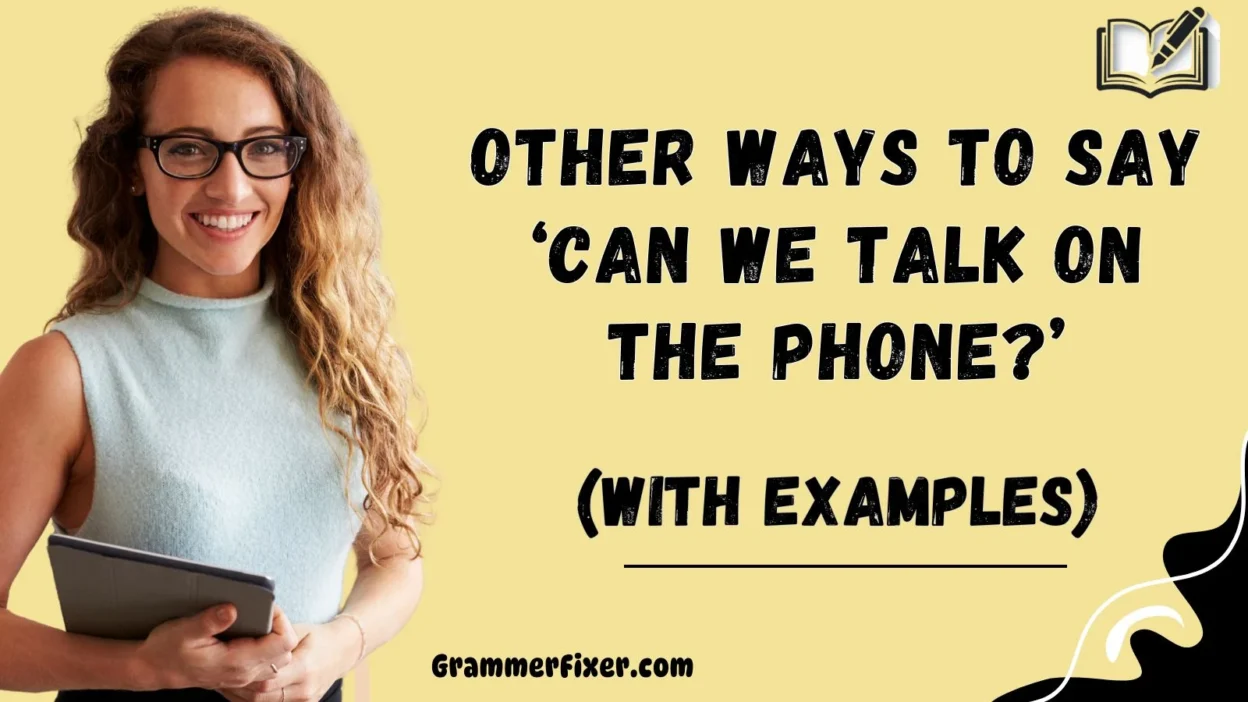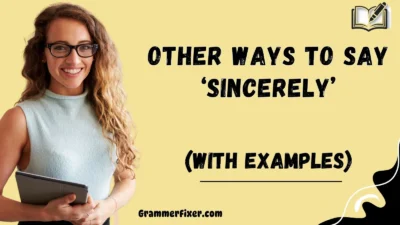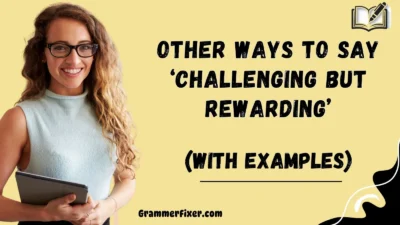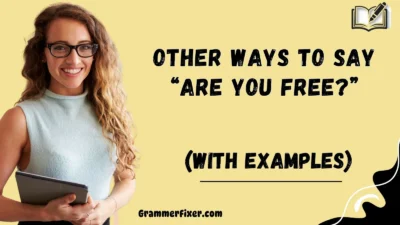Sometimes, how we ask to talk can make all the difference. The phrase “Can we talk on the phone?” might sound simple, but in professional or thoughtful communication, your choice of words can shape how your message is received. Finding the right tone—warm, polite, and clear— helps show respect for the other person’s time and sets a positive tone for the conversation.
Below are 30 thoughtful and professional alternatives you can use to sound more approachable, caring, and polished in your messages.
What Does “Can We Talk on the Phone” Professionally Mean?
The phrase “Can we talk on the phone professionally” means politely asking someone to have a phone conversation in a respectful, business-appropriate way. It’s often used when email or chat feels too limited for clear communication, or when you want to build rapport and connection through voice conversation.
When to Use “Can We Talk on the Phone” Professionally?
Use this phrase when you need to:
- Discuss sensitive or complex matters
- Clarify details faster than text allows
- Strengthen relationships or trust
- Avoid misunderstandings in writing
It’s ideal in business communication, client relations, interviews, mentorships, and collaborative settings.
Is It Professional/Polite to Say “Can We Talk on the Phone”?
Yes — it’s perfectly polite and professional when phrased thoughtfully. To make it sound warm and considerate, add context or flexibility. For example:
- “Would you be open to a quick phone chat this week?”
- “I’d love to discuss this briefly over a call if that works for you.”
Pros or Cons of Saying “Can We Talk on the Phone” Professionally
Pros:
- Builds personal connection
- Helps clarify tone and intent
- Speeds up problem-solving
Cons:
- May feel intrusive if unplanned
- Can interrupt someone’s workflow
- Not ideal for time-sensitive written records
1. “Would You Be Available for a Quick Call?”
Meaning: A gentle, polite way to ask if the other person has time for a short phone discussion.
Detailed Explanation: This phrase emphasizes respect for the other person’s schedule by saying “quick,” which sounds mindful.
Scenario Example:
“Would you be available for a quick call tomorrow to finalize the project details?”
Best Use: When reaching out to busy professionals or clients.
Worst Use: When the discussion is likely to take a long time.
Why It Works: It’s considerate and efficient.
Tone: Polite, professional, and respectful.
2. “Could We Schedule a Brief Phone Chat?”
Meaning: Suggests setting a time for a focused discussion.
Detailed Explanation: Adding “schedule” makes it feel more structured and professional.
Scenario Example:
“Could we schedule a brief phone chat to review your feedback?”
Best Use: For planned business discussions.
Worst Use: For spontaneous or urgent matters.
Why It Works: It respects time boundaries.
Tone: Organized and respectful.
3. “Would You Mind a Quick Phone Conversation?”
Meaning: A courteous and soft request that gives the other person room to decline.
Detailed Explanation: “Would you mind” adds empathy and deference.
Scenario Example:
“Would you mind a quick phone conversation about the proposal?”
Best Use: When approaching someone senior or unfamiliar.
Worst Use: For informal chats.
Why It Works: Shows emotional intelligence.
Tone: Polite and deferential.
4. “Can I Give You a Quick Call?”
Meaning: Suggests you’ll take the initiative to call, keeping it short.
Detailed Explanation: It’s casual yet polite, suitable for familiar contacts.
Scenario Example:
“Can I give you a quick call to clarify this?”
Best Use: For ongoing collaborations.
Worst Use: For first-time or high-level contacts.
Why It Works: Feels natural and confident.
Tone: Friendly and direct.
5. “Shall We Discuss This Over the Phone?”
Meaning: Proposes moving from text to a call to talk through details.
Detailed Explanation: “Shall we” sounds collaborative rather than directive.
Scenario Example:
“Shall we discuss this over the phone to clear up a few points?”
Best Use: When working as equals or in a team.
Worst Use: When asking a superior without flexibility.
Why It Works: Promotes cooperation.
Tone: Collaborative and professional.
6. “Would You Prefer a Call to Go Over This?”
Meaning: Offers choice and flexibility, showing respect.
Detailed Explanation: It gently invites a call without pressure.
Scenario Example:
“Would you prefer a call to go over the timeline?”
Best Use: When the other person’s communication style is unknown.
Worst Use: When urgency is required.
Why It Works: It empowers the listener.
Tone: Respectful and flexible.
7. “May I Call You to Discuss This?”
Meaning: Formal, polite, and suitable for professional communication.
Detailed Explanation: Using “May I” makes it sound particularly respectful.
Scenario Example:
“May I call you to discuss this further?”
Best Use: When communicating with senior professionals or clients.
Worst Use: For informal peers.
Why It Works: It conveys deference.
Tone: Formal and courteous.
8. “Would a Quick Phone Call Work for You?”
Meaning: Offers convenience and consideration.
Detailed Explanation: Centers the other person’s schedule as the priority.
Scenario Example:
“Would a quick phone call work for you tomorrow morning?”
Best Use: For scheduling short discussions.
Worst Use: When you need an in-depth meeting.
Why It Works: It’s polite and efficient.
Tone: Respectful and adaptable.
9. “Can We Hop on a Call to Go Over the Details?”
Meaning: A friendly, modern alternative that implies collaboration.
Detailed Explanation: “Hop on a call” is informal but professional in many industries.
Scenario Example:
“Can we hop on a call to go over the next steps?”
Best Use: In team communication or startup culture.
Worst Use: In conservative or highly formal settings.
Why It Works: Sounds energetic and easygoing.
Tone: Conversational and collaborative.
10. “Would You Have Time for a Quick Call?”
Meaning: Respects the person’s time while asking for a chat.
Detailed Explanation: Puts the decision in their hands, showing courtesy.
Scenario Example:
“Would you have time for a quick call today?”
Best Use: For considerate outreach.
Worst Use: For spontaneous or urgent issues.
Why It Works: It’s humble and kind.
Tone: Professional and thoughtful.
11. “Could I Give You a Ring Later Today?”
Meaning: A more casual, friendly version of asking for a call.
Detailed Explanation: Works well in semi-formal or friendly professional contexts.
Scenario Example:
“Could I give you a ring later today to chat about this?”
Best Use: With colleagues or clients you know well.
Worst Use: In formal settings.
Why It Works: It’s personable and approachable.
Tone: Warm and friendly.
12. “Would You Be Open to a Short Call?”
Meaning: Invites without pressure; conveys openness.
Detailed Explanation: Suggests flexibility and consideration.
Scenario Example:
“Would you be open to a short call to discuss the changes?”
Best Use: For client relationships and sensitive topics.
Worst Use: When time is extremely limited.
Why It Works: It’s considerate and permission-based.
Tone: Empathetic and respectful.
13. “Let’s Schedule a Time to Chat by Phone.”
Meaning: Confident and proactive phrasing that plans ahead.
Detailed Explanation: Suggests initiative and structure.
Scenario Example:
“Let’s schedule a time to chat by phone about next week’s deliverables.”
Best Use: For team planning or leadership roles.
Worst Use: When seeking permission from a superior.
Why It Works: It’s confident and organized.
Tone: Assertive yet warm.
14. “Could We Arrange a Quick Call?”
Meaning: A formal and courteous way to suggest organizing a phone conversation.
Detailed Explanation: The word “arrange” implies professionalism and respect for planning ahead.
Scenario Example:
“Could we arrange a quick call to finalize the design revisions?”
Best Use: When proposing a call in a business context or with clients.
Worst Use: When the matter is urgent and doesn’t need scheduling.
Why It Works: It’s structured and time-considerate.
Tone: Professional and polite.
15. “Would You Be Free for a Phone Discussion?”
Meaning: A direct yet considerate way to inquire about availability.
Detailed Explanation: Highlights respect for the person’s time by focusing on their “free” slots.
Scenario Example:
“Would you be free for a phone discussion tomorrow afternoon?”
Best Use: When scheduling calls with busy professionals.
Worst Use: When spontaneity is acceptable.
Why It Works: Shows courtesy and awareness.
Tone: Respectful and formal.
16. “Can We Touch Base Over the Phone?”
Meaning: A friendly and efficient phrase meaning to reconnect or align on details.
Detailed Explanation: “Touch base” conveys casual professionalism and teamwork.
Scenario Example:
“Can we touch base over the phone later to review next steps?”
Best Use: For colleagues or project partners.
Worst Use: In very formal written communication.
Why It Works: Builds rapport while sounding professional.
Tone: Friendly and collaborative.
17. “Mind If We Chat Over the Phone?”
Meaning: A gentle and informal way to request a conversation.
Detailed Explanation: “Mind if we” softens the request, making it sound approachable.
Scenario Example:
“Mind if we chat over the phone about the update?”
Best Use: With familiar colleagues or clients.
Worst Use: When formality is expected.
Why It Works: It’s warm, natural, and conversational.
Tone: Friendly and casual.
18. “Would a Call Be Easier to Discuss This?”
Meaning: Suggests that a phone call might simplify communication.
Detailed Explanation: A tactful way to move from written messages to a call.
Scenario Example:
“Would a call be easier to discuss this instead of emailing back and forth?”
Best Use: When there’s back-and-forth confusion in emails.
Worst Use: When the other party prefers written communication.
Why It Works: It offers convenience and efficiency.
Tone: Helpful and considerate.
19. “Are You Available for a Phone Discussion?”
Meaning: Straightforward, formal, and respectful inquiry about time availability.
Detailed Explanation: Ideal when confirming schedules or setting professional boundaries.
Scenario Example:
“Are you available for a phone discussion this week?”
Best Use: For formal business communication.
Worst Use: For close colleagues or casual chats.
Why It Works: Sounds polished and clear.
Tone: Formal and professional.
20. “Let’s Have a Quick Catch-Up Call.”
Meaning: Suggests a light, informal conversation to reconnect.
Detailed Explanation: Perfect when you want to maintain professional relationships.
Scenario Example:
“Let’s have a quick catch-up call to go over recent updates.”
Best Use: For maintaining rapport and ongoing communication.
Worst Use: For discussing serious or complex matters.
Why It Works: Encourages friendly engagement.
Tone: Warm and friendly.
21. “Could We Have a Brief Conversation by Phone?”
Meaning: A polite and neutral way to suggest a short phone talk.
Detailed Explanation: Combines courtesy with precision—“brief” and “by phone” make it professional.
Scenario Example:
“Could we have a brief conversation by phone to clarify a few details?”
Best Use: For formal professional messages.
Worst Use: In overly casual interactions.
Why It Works: Balances professionalism and clarity.
Tone: Respectful and formal.
22. “Is Now a Good Time for a Call?”
Meaning: Checks the person’s immediate availability in a polite tone.
Detailed Explanation: Ideal for spontaneous yet respectful outreach.
Scenario Example:
“Is now a good time for a call, or would later work better?”
Best Use: For real-time or urgent communication.
Worst Use: In written emails for long-term scheduling.
Why It Works: Acknowledges the other person’s timing.
Tone: Polite and conversational.
23. “Would It Be Okay If I Called You?”
Meaning: A gentle and considerate way to ask permission to call.
Detailed Explanation: Perfect when you’re unsure about the person’s comfort with calls.
Scenario Example:
“Would it be okay if I called you to explain this in detail?”
Best Use: When approaching new or senior contacts.
Worst Use: When urgency requires directness.
Why It Works: Shows emotional intelligence and respect.
Tone: Courteous and warm.
24. “Can We Discuss This Verbally?”
Meaning: Suggests switching from text to speech for clarity.
Detailed Explanation: It’s a more technical and professional way to say “talk on the phone.”
Scenario Example:
“Can we discuss this verbally? It might help avoid confusion.”
Best Use: For project reviews, clarification, or technical topics.
Worst Use: For casual or social discussions.
Why It Works: Sounds precise and solution-oriented.
Tone: Analytical and professional.
25. “Shall We Jump on a Quick Call?”
Meaning: Friendly and upbeat phrasing for a brief phone chat.
Detailed Explanation: “Jump on” conveys energy and collaboration.
Scenario Example:
“Shall we jump on a quick call to finalize the report?”
Best Use: In team or startup environments.
Worst Use: In formal or hierarchical communications.
Why It Works: Feels dynamic and engaging.
Tone: Modern and energetic.
26. “Can We Connect by Phone Today?”
Meaning: Suggests a professional connection over the phone.
Detailed Explanation: “Connect” implies networking and collaboration.
Scenario Example:
“Can we connect by phone today to go through the next steps?”
Best Use: For relationship-building and follow-ups.
Worst Use: For strictly transactional topics.
Why It Works: Encourages professional rapport.
Tone: Professional and friendly.
27. “Would You Be Comfortable Talking by Phone?”
Meaning: Checks comfort levels before suggesting a call.
Detailed Explanation: Ideal for sensitive topics or new relationships.
Scenario Example:
“Would you be comfortable talking by phone about this issue?”
Best Use: For emotional, sensitive, or personal discussions.
Worst Use: For standard project updates.
Why It Works: Demonstrates empathy and tact.
Tone: Compassionate and respectful.
28. “Could I Reach Out by Phone to Explain?”
Meaning: Indicates willingness to clarify things directly.
Detailed Explanation: The phrase “reach out” adds warmth and initiative.
Scenario Example:
“Could I reach out by phone to explain the process in detail?”
Best Use: When needing to clarify something complex.
Worst Use: For routine communication.
Why It Works: Shows helpfulness and initiative.
Tone: Helpful and approachable.
29. “Would a Quick Chat Over the Phone Help?”
Meaning: Suggests a call as a possible solution to streamline communication.
Detailed Explanation: Focuses on helpfulness rather than the request itself.
Scenario Example:
“Would a quick chat over the phone help clear this up?”
Best Use: For problem-solving or collaborative work.
Worst Use: When written clarification suffices.
Why It Works: It’s supportive and constructive.
Tone: Cooperative and positive.
30. “Let’s Talk This Through on a Call.”
Meaning: Suggests working through something together via phone.
Detailed Explanation: Perfect for resolving complex topics with empathy and clarity.
Scenario Example:
“Let’s talk this through on a call so we can make a clear decision.”
Best Use: When resolving issues or aligning perspectives.
Worst Use: For brief or transactional exchanges.
Why It Works: Encourages teamwork and understanding.
Tone: Supportive and collaborative.
Conclusion
Finding the right words to request a phone conversation can completely change the tone of your communication. Whether you’re reaching out to a client, manager, or colleague, using these 30 alternatives helps you sound thoughtful, confident, and emotionally intelligent.
Remember — the goal isn’t just to “talk on the phone,” but to create meaningful and respectful dialogue. The right phrase shows you value the other person’s time, tone, and comfort — transforming a simple phone call into a moment of connection and professionalism.



